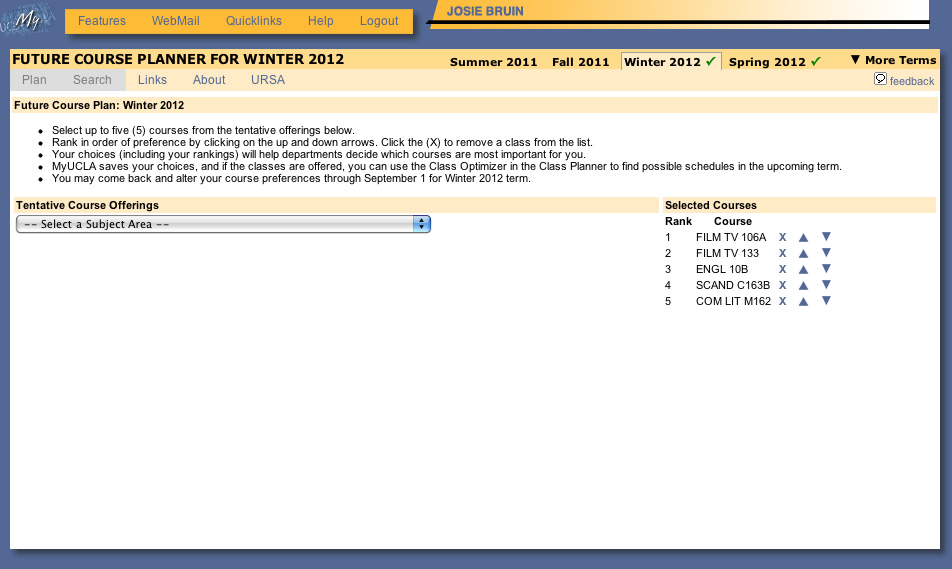MyUCLA's Future Course Planner gathers student input on scheduling, offerings

The Future Class Planner, a new feature now available on MyUCLA, allows students to project their class schedules for the rest of the school year.
Photo illustration by Rei Estrada
By James Barragan
Sept. 16, 2011 2:33 p.m.
UCLA administrators and department officials are seeking student input for course scheduling purposes with a recently launched tool that allows students to project their schedule of classes for the rest of the year.
The online tool launched in June as part of the existing MyUCLA Class Planner.
Using color codes which rank importance and urgency, the Future Course Planner allows students to tell their departments what classes they are interested in taking during upcoming quarters, said Christian Spreitzer, director of undergraduate information technology.
The information helps departments adjust their course plans, if necessary, Spreitzer said.
“They’re trying to find courses that are hot points, where offerings are too little,” Spreitzer said. “Then maybe they can add course offerings in classes where there’s need or desire.”
There will not be any guarantees, however, that the exact classes students want will be offered ““ only a closer match, said Roxanne Neal, director of the UCLA New Student & Transition Program.
Neal introduced the Future Course Planner to orientation programs for new and transfer students. About 12 percent of incoming students used the planning tool, she said.
The course planner could help identify and address extreme problems for both classes lacking student interest and classes which need more course offerings, said Richard Wesel, associate dean of academic and student affairs of the UCLA Henry Samueli School of Engineering.
With the additional information from the course planner, departments could possibly open up more sections for classes, which many students are demanding, said Julie Sina, chief of staff for the UCLA College of Letters and Sciences.
“If we see from a course planner that we need more seats, we’re going to try to do it,” Wesel said.
However, the opportunity for this would vary from department to department, Wesel said.
As of the beginning of September, about 8,000 students had used the course planner ““ slightly less than 33 percent of the campus’ entire population.
“This is a tool that’s exactly as valuable as the percentage of students who fill it out,” Wesel said. “If all students complete it, it’s extremely valuable and can help UCLA do a better job at getting students what they need.”
Beside helping students and departments plan their schedules for the upcoming courses, the tool could also serve as an opportunity for departments to reach out to and communicate with their students, Sina said.
Requirements for some majors have changed over time, but some students who may not be aware of those changes may still be planning for classes they don’t need any more, she said.
“It would be easy for me as a chair (of a department) or faculty member to write to a student and let them know things have changed,” Sina said.
Third-year mathematics/economics student Jamie Kuei saw the planner on MyUCLA but hasn’t used it yet. She’s trying to pick up a minor in theater and has hard a hard time getting into requirement classes for her two majors. One math class for which she needs to sign up has about 30 spaces.
She said it’s unlikely that students will use a tool that does not officially secure classes. She is unable to plan that far in advance without knowing the surrounding factors of her schedule, she said.
“I hope it helps, but I have my doubts,” Kuei said.
Elizabeth Landaw, assistant dean of social sciences, said the tool is still a work in progress and the optimal use of the course planner will come when a larger amount of the student population hears about what the tool does.
Spreitzer said the tool helps communication between administration and students. He added that this is the first time on a campus-wide level where students’ input is combined with the information administrators already have.
“It’s an experiment,” Spreitzer said. “The more students participate, the more it will become.”

